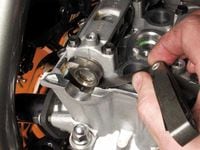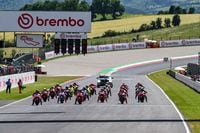QUESTION: My Suzuki S40 air-cooled engine requires checking the valves for potential adjustment every 4,500 miles. There are other motorcycles that need adjustment checks only after a much longer period of time. These mileage requirements can vary greatly depending on the make and model of the motorcycle.
Why are mileage requirements for valve adjustments so different on different motorcycles? How do the engineers decide on the valve adjustment mileage interval?
Ron Glaum
CycleWorld.com
ANSWER: Thank you for your interesting question. First of all, there must be some cold clearance in the valve train to allow for heat expansion of the valves in operation. If clearance becomes too small, valves may leak. If too big, there is valve clatter. We want that clearance to be just right.
As an engine runs, its valve train is subject to some wear of cam lobes and tappets—wear that tends to increase cold valve clearance. At the same time, so-called valve seat recession also takes place. When the valves are on their seats, some local micro-welding of valve to seat takes place. When the valve lifts, the micro-welds are broken, creating wear particles. This loss of material causes the valve to ever-so-slowly seat more deeply, decreasing cold valve clearance. Valve train and seat wear can occur more quickly with use of aggressive cam profiles, which typically require stiffer springs, causing cam and tappet to wear from extra seat pressure. Same for seats, when higher rate springs shut valves harder. Ideally, the two gradual effects would pretty much cancel, resulting in constant clearance. If there's more money in the budget to assure this desirable outcome on premium models than on lower-markup bikes, we can just chalk that up to a free market economy.

/cloudfront-us-east-1.images.arcpublishing.com/octane/GF43ABW66NDBZBEBCA2CY24EAI.jpg)
/cloudfront-us-east-1.images.arcpublishing.com/octane/4YSY335TXPUVXICZKUMMOSQ63A.jpg)
/cloudfront-us-east-1.images.arcpublishing.com/octane/A4EN3OE2HRBXVFICJ6K62CNXCM.jpg)
/cloudfront-us-east-1.images.arcpublishing.com/octane/ZBLIY3XNQ5ACNNJ65IL44KBZAE.jpg)
/cloudfront-us-east-1.images.arcpublishing.com/octane/HDO56KGQB5H25DJRM2J2PH2E5A.jpg)
/cloudfront-us-east-1.images.arcpublishing.com/octane/NZKPFUWBHVGYJAFQPCXWAK6BZM.jpg)
/cloudfront-us-east-1.images.arcpublishing.com/octane/K5ZSQFMYQZHWRFXTTW4PEWMUDM.jpg)
/cloudfront-us-east-1.images.arcpublishing.com/octane/D2SOSBIQQRBPTERNSOJRAW3KYY.jpg)
/cloudfront-us-east-1.images.arcpublishing.com/octane/DS3Q5X2VJFFAJDK2PWB3Y7K6U4.jpg)
/cloudfront-us-east-1.images.arcpublishing.com/octane/4KBL4JAMYRFDPEINTWATDUH7OM.jpg)
/cloudfront-us-east-1.images.arcpublishing.com/octane/FXADK3MVSNBRTKJ2B7TPDCCJ5Y.jpg)
/cloudfront-us-east-1.images.arcpublishing.com/octane/M7L2CPXO55FRFMECW7QGDPGP6E.jpg)
/cloudfront-us-east-1.images.arcpublishing.com/octane/T4RWGLAEHVE2VCJZOTFTNGB2KA.jpg)
/cloudfront-us-east-1.images.arcpublishing.com/octane/JM4QGLAHWNGHPM74OEB7FVBFSY.jpg)
/cloudfront-us-east-1.images.arcpublishing.com/octane/BGPNXPDDYBHD3HL6YEZQOYHXTI.jpg)
/cloudfront-us-east-1.images.arcpublishing.com/octane/SND5GGQV4RDPPMZBSBEGIZ4SIY.jpg)
/cloudfront-us-east-1.images.arcpublishing.com/octane/XUDDAPYZMZEL5EDPVDJ2DTULWI.jpg)
/cloudfront-us-east-1.images.arcpublishing.com/octane/M7AU2L6GAVCJVHW57LIRPDAAUQ.jpg)

/cloudfront-us-east-1.images.arcpublishing.com/octane/JKEJY7P43JGD5C5NJO2VJQJPUM.jpg)
/cloudfront-us-east-1.images.arcpublishing.com/octane/YROKYJYUQVGPHCEMPTGBWDQCKQ.jpg)
/cloudfront-us-east-1.images.arcpublishing.com/octane/QIHEYR66TZDAPCGMWHCWCBC4XA.jpg)
/cloudfront-us-east-1.images.arcpublishing.com/octane/4FTBMNZL5BD2ZHY62XXRHJW6PI.jpg)
/cloudfront-us-east-1.images.arcpublishing.com/octane/L2BHKRCEMFDF7O3S4REZXPDH2E.jpg)